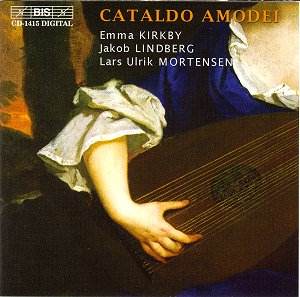Sicilian-born in 1649,
Cataldo Vito Amodei, something of a
child prodigy, entered Holy Orders in
Naples. Concurrently he held teaching
positions as choirmaster and in colleges.
He wrote a considerable amount of sacred
music for which there was seemingly
an unending demand and equally it seems
to have worn Amodei down because he
resigned his positions in the city in
1688. His successor was the decade-younger
Alessandro Scarlatti (who lasted five
months). Amodei’s greatest interest
was in devotional music and his Op.1
contained a number of motets for 2,
3, 4 and 5 voices (the parts of which
have come down to us incomplete) .His
Op.2 was printed as Cantate a voce
sola in 1685 and contained thirteen
pieces for soprano and basso continuo.
The texts are anonymous though conventional
– primarily secular and Arcadian though
three are products of the devotional
genre so popular at the time.
Amodei employs a rich
harmonic palette throughout and often
deploys rather florid, melismatic vocal
lines. Su l’ore che l’aurora, the
longest setting here at nearly twelve
minutes in length, uses a sort of vocalise
recitativo as well as colouristically
and graphically word-painting through
melismatic undulations. The colour he
can use is, though, better heard in
Tra l’erbette il piè sciogliea
where he boldly colours expressive-pictorial
lines, uses unaccompanied recitative
passages, and spins pensive melismas
with almost operatic economy. The yearning
strain is completed by the finale in
which, in ascending lines, in differing
registers, Amodei draws to a perfect
close – textual explication matched
by musical understanding. Similarly
a setting such as Va’, ché
l’hai fatto a me is notable for
its intensity and compression – and
lest one gives the impression that Amodei
preferred Arcadian Vocalise, he lets
rip with a taxing fast section in Già
col manto dell’ombre. He learned
what, say Caldara learned from Alessandro
Scarlatti, in terms of pictorialism
and close attention to textual detail.
We can hear this in the fluttering and
expressive melsimatic lines of Colà
dove il Sebeto.
The disc is happily
rounded out with one work each by little
known composers Zamboni and Storace,
so little known in fact that we know
neither the years of their birth nor
death. Zamboni’s Sonata for archlute
is in the expected five dance movements
and is effectively written with a particularly
lithe and free-flowing fourth-movement
Sarabanda. Storace wrote his Passacagli
sopra Alamire for harpsichord solo and
it formed part of his only published
collection – from which we know, at
least, that he worked in Messina. It’s
a well-argued and cogent series of variations
that shows a level of invention well
above the normal.
These three little-known
composers receive performances of perception
from three well-known interpreters of
the early muse. Even Kirkby is sometimes
stretched by some of Amodei’s considerable
demands – in something like Va’,
ché l’hai fatto a me the
technical difficulties in the higher
register are pronounced. Altogether
however BIS have uncovered a notable
composer and brought him back to sometimes
startling life.
Jonathan Woolf


